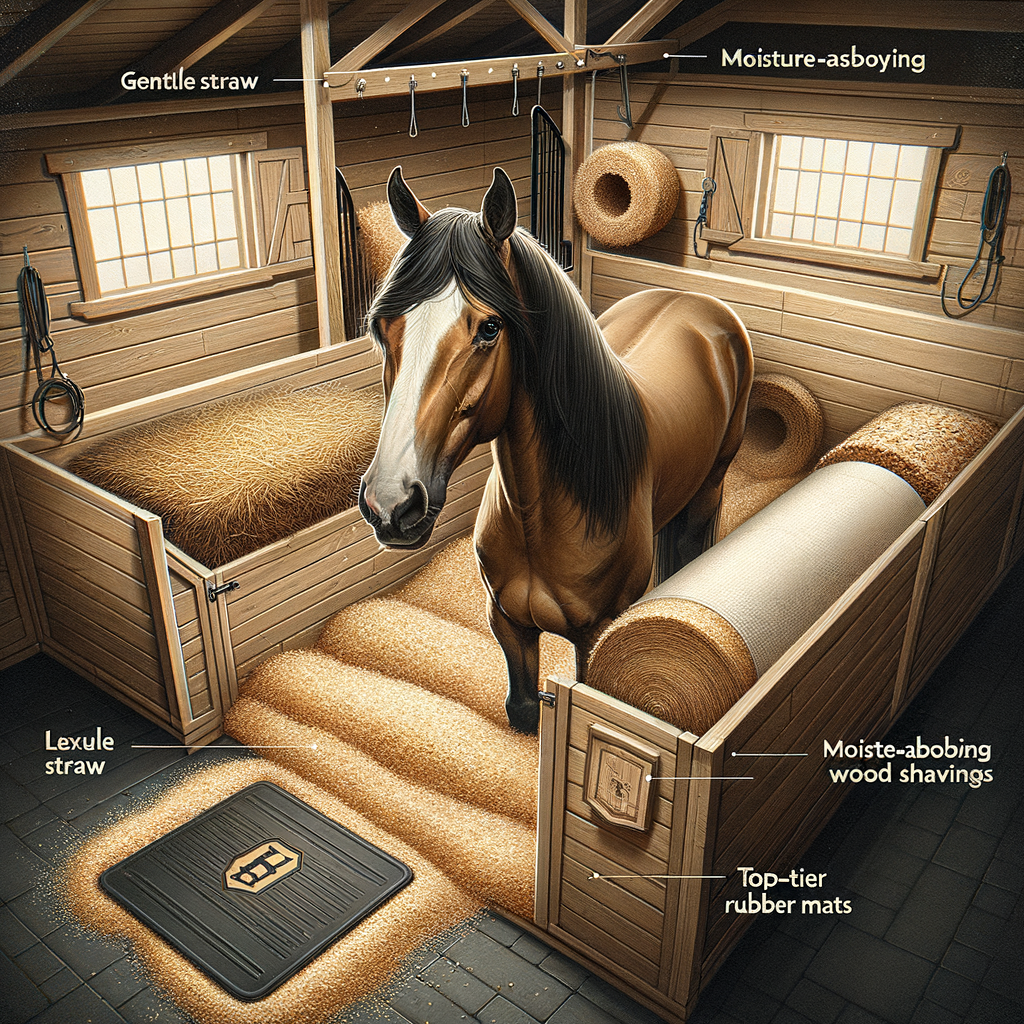
Introduction to Best Bedding for Quarter Horse Stalls
Choosing the right bedding for your quarter horse stall is crucial. It affects your horse’s health, comfort, and overall well-being. In this section, we will discuss why selecting the best bedding is important and the factors you should consider when making your choice.
- Importance of choosing the right bedding:Good bedding provides a comfortable place for your horse to rest. It also helps keep the stall clean and dry. Proper bedding can prevent injuries and reduce the risk of infections. Additionally, it can improve the air quality in the stall by reducing dust.
- Factors to consider when selecting bedding:When choosing bedding, consider the following factors:
- Absorbency: Bedding should absorb moisture well to keep the stall dry.
- Comfort: The bedding should be soft and comfortable for your horse to lie on.
- Dust levels: Low-dust bedding is better for your horse’s respiratory health.
- Cost: Consider the cost of the bedding and how often it needs to be replaced.
- Availability: Ensure the bedding is readily available in your area.
Top Bedding Options for Quarter Horse Stalls
Straw
- Benefits of using strawA popular bedding choice for many horse owners. It is soft and comfortable for horses to lie on. Straw is also very absorbent, which helps keep the stall dry. Additionally, straw is usually easy to find and relatively inexpensive.
- Drawbacks of using strawWhile straw has many benefits, it also has some drawbacks. It can be dusty, which may cause respiratory issues for some horses. Straw also needs to be replaced frequently as it can become moldy if it gets wet. Cleaning a stall with straw bedding can be time-consuming because it tends to mix with manure.
Wood Shavings
- Advantages of wood shavingsWood shavings are a popular choice for horse stalls. They are soft and comfortable for horses to lie on. This bedding type is also good at absorbing moisture, which helps keep the stall dry and clean. Many horse owners find wood shavings easy to handle and spread. They also have a pleasant smell, which can improve the overall environment of the stable.
Advantage Details Comfort Soft and cushy for horses Absorbent Helps keep stalls dry Easy to use Simple to handle and spread Pleasant smell Improves stable environment -
Disadvantages of wood shavings
One major drawback is that they can be dusty, which might cause respiratory issues for some horses. Additionally, wood shavings can be more expensive compared to other bedding options like straw. They also need to be cleaned out regularly to prevent the buildup of ammonia from urine, which can be harmful to horses.
Disadvantage Details Dusty Can cause respiratory issues Cost More expensive than straw Maintenance Needs regular cleaning
Pelleted Bedding
-
Pros of pelleted bedding
-
- Absorbency: Pelleted bedding is highly absorbent. It can soak up a lot of moisture, keeping the stall dry.
- Dust-Free: This type of bedding produces less dust compared to straw or wood shavings. This is better for horses with respiratory issues.
- Easy to Clean: Pellets break down into a soft, fluffy material that is easy to sift and clean.
- Cost-Effective: Although the initial cost may be higher, pelleted bedding lasts longer, making it more economical in the long run.
- Eco-Friendly: Many pelleted beddings are made from recycled materials, making them an environmentally friendly option.
-
-
Cons of pelleted bedding
-
- Initial Preparation: Pellets need to be moistened before use. This can be time-consuming.
- Availability: Pelleted bedding may not be available in all areas, making it harder to source.
- Cost: The upfront cost can be higher than other bedding types, which may be a concern for some horse owners.
- Temperature Sensitivity: Pelleted bedding can become hard in cold weather, which might be uncomfortable for the horse.
Quarter Horse Stall Bedding Recommendations
- Consider the horse’s health: The health of your Quarter Horse should be the top priority. Choose bedding that is dust-free to prevent respiratory issues. For example, wood shavings are often recommended because they are low in dust. According to a study, horses exposed to dusty environments are more likely to develop breathing problems.
- Consider the horse’s comfort: Comfort is crucial for your horse’s well-being. Soft bedding materials like straw or shredded paper can provide a comfortable resting place. A comfortable horse is less likely to develop sores or other health issues. Think about how you would feel sleeping on the bedding you choose for your horse.
- Consider the cost and availability of the bedding material: The cost and availability of bedding materials can vary. Wood shavings might be more expensive but are often easier to find. Straw can be cheaper but may not be available year-round. Make sure to balance cost with the benefits to your horse’s health and comfort.
Bedding Choices for Quarter Horse Stalls: Case Studies
Case Study 1: Straw Bedding
- Overview of the case study: This case study examines the use of straw as bedding for Quarter Horse stalls. Straw is a traditional bedding material that is often used because it is readily available and cost-effective. In this study, a stable with 10 Quarter Horses used straw bedding for a period of six months. The horses’ health, comfort, and stall cleanliness were monitored closely.
-
Key takeaways:
- Comfort: The horses appeared comfortable and rested well on the straw bedding. Straw provides a soft surface that is gentle on the horses’ joints.
- Absorbency: While straw is not as absorbent as some other materials, it did an adequate job of keeping the stalls dry. Regular cleaning was necessary to maintain hygiene.
- Cost: Straw is one of the more affordable bedding options. The stable reported significant cost savings over the six-month period.
- Maintenance: Straw bedding required daily cleaning to remove soiled areas and replenish fresh straw. This helped to control odors and maintain a clean environment.
- Health: No significant health issues were observed in the horses during the study. However, it is important to note that straw can sometimes harbor dust and mold, which could affect horses with respiratory issues.
Case Study 2: Wood Shavings Bedding
Overview of the case study
Wood shavings are a popular choice for horse stall bedding. In this case study, we looked at a stable that switched from straw to wood shavings. The stable had 20 Quarter Horses, and they wanted to see if wood shavings would be a better option.
The stable used pine wood shavings, which are known for their softness and absorbency. They monitored the horses’ health, stall cleanliness, and overall costs over a period of six months.
Key takeaways
- Better Absorbency: Wood shavings absorbed urine better than straw, keeping the stalls drier.
- Comfort: Horses seemed more comfortable lying on the soft wood shavings.
- Less Dust: Pine shavings produced less dust, which is better for the horses’ respiratory health.
- Cost: Although wood shavings were initially more expensive, they lasted longer, making them cost-effective in the long run.
| Aspect | Wood Shavings | Straw |
|---|---|---|
| Absorbency | High | Medium |
| Comfort | High | Medium |
| Dust Levels | Low | High |
| Cost | Moderate | Low |
The stable found that wood shavings provided a better environment for their Quarter Horses. The horses were healthier and more comfortable, and the stalls were easier to maintain.
Optimal Bedding for Quarter Horse Stalls
-
Factors that determine the optimal bedding:
- Comfort: The bedding should be soft and comfortable for the horse to lie down on.
- Absorbency: Good bedding absorbs moisture and keeps the stall dry.
- Dust Levels: Low-dust bedding is better for the horse’s respiratory health.
- Cost: The price of bedding can vary, so it’s important to find an affordable option.
- Availability: The bedding should be easy to find and purchase.
-
Examples of optimal bedding choices:
- Wood Shavings: These are soft and absorbent, making them a popular choice.
- Straw: Straw is affordable and provides good insulation.
- Pelleted Bedding: This type is highly absorbent and easy to clean.
- Shredded Paper: This is a dust-free option, which is great for horses with allergies.
Conclusion: Best Materials for Quarter Horse Bedding
- Summary of the best bedding options:After reviewing various materials, the best bedding options for Quarter Horse stalls include:
- Wood Shavings: Soft, absorbent, and comfortable for horses.
- Straw: Traditional, cost-effective, and easy to clean.
- Pelleted Bedding: Highly absorbent and reduces waste.
- Rubber Mats: Durable and provides a cushioned surface.
-
Final recommendations:
Choosing the right bedding is crucial for your Quarter Horse’s health and comfort. Here are our final recommendations:
- Consider your horse’s specific needs and preferences.
- Evaluate the cost and availability of bedding materials in your area.
- Ensure the bedding is easy to clean and maintain.
- Mix and match different types of bedding for optimal results.
By selecting the best bedding, you can create a safe and comfortable environment for your Quarter Horse.









